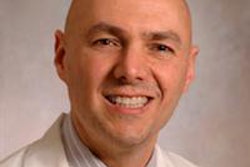
DrBicuspid.com is pleased to present the next installment of Leaders in Dentistry, a series of interviews with researchers, practitioners, and opinion leaders who are influencing the practice of dentistry.
We spoke with John S. Greenspan, BDS, PhD, a professor of oral pathology and the associate dean for global oral health at the School of Dentistry at the University of California, San Francisco (UCSF). Dr. Greenspan is founding director of several of UCSF's AIDS programs, including the Oral AIDS Center, the California AIDS Research Center, and the UCSF AIDS Specimen Bank. He headed the campus' $140 million-per-year AIDS Research Institute from 2003 to 2012. Dr. Greenspan's group established a link between oral lesions and HIV-positive gay men in San Francisco, which made headlines after it was published in 1984 by Lancet. He will receive the ADA Gold Medal Award for Excellence in Dental Research in October during the association's annual meeting in San Francisco.
Dr. Greenspan's research includes the oral aspects of AIDS and the role of viruses in oral epithelial and salivary gland lesions. He has published almost 300 papers and four books on the oral aspects of AIDS, oral pathology, and immunopathology. He is also the director of the Sjögren's International Collaborative Clinical Alliance. Dr. Greenspan's current research focuses on global oral health and how oral health affects overall health.
DrBicuspid.com: How did you discover the connection between hairy leukoplakia, Epstein-Barr virus (EBV), and HIV?
 John S. Greenspan, BDS, PhD. Images courtesy of Susan Merrell and UCSF.
John S. Greenspan, BDS, PhD. Images courtesy of Susan Merrell and UCSF.
Dr. Greenspan: At the beginning of the AIDS epidemic in 1981, my wife, Deborah Greenspan, BDS, DSc, an oral medicine specialist, was working with our colleague Sol Silverman, DDS, and other UCSF faculty, and they started to see patients with Kaposi's sarcoma, part of which was subsequently called AIDS. But for the first few years it didn't have a name. In the first research papers about AIDS, they talked about mouth lesions. Kaposi's sarcoma is a vascular malignancy that wasn't seen much before AIDS. And it was the first tumor of AIDS, and we started to see those biopsies. Deborah started to see a novel whiter lesion of the lateral tongue.
So they called me and other pathologists and asked what we thought it was. We didn't know. I thought maybe it was premalignant leukoplakia but histology for that was negative. It was leukoplakia but it wasn't premalignant. Then I thought it might be due to human papillomavirus (HPV). But when we did electron microscopy, we found lots and lots of a virus of a different group, the herpes virus group, which includes herpes simplex 1 and 2, cytomegalovirus (CMV), varicella-zoster virus, and EBV. We then used other techniques and discovered it was EBV. So that was a discovery; that was a new thing.
We then looked at these patients and they didn't have AIDS when they came in, but they developed AIDS at a disproportionate rate. But when we discovered HIV, there it was. They had a lot of the equivalent of what we now call HIV.
Now we measure HIV viral load using RNA and DNA; in those days we didn't have that but instead cultured the virus. It was obvious they had very high HIV infection and a very low CD4 count, so they were about to get full-blown AIDS. They had HIV infection and they were progressing. We quickly discovered it was EBV, and it was about the same time that HIV was discovered, and we put two and two together.
How did you come to name the AIDS lesion hairy leukoplakia?
 Drs. Deborah and John Greenspan, who discovered the oral viral lesion hairy leukoplakia, which is linked to HIV/AIDS.
Drs. Deborah and John Greenspan, who discovered the oral viral lesion hairy leukoplakia, which is linked to HIV/AIDS.
Actually, my wife, Deborah and I discovered hairy leukoplakia together. It was completely unknown. We were seeing this white thing, and we knew it was some kind of unknown leukoplakia. One day, one of our colleagues, the oral surgeon Richard Smith, DDS, called Deborah and he said, "I've got a patient with that lesion that you've been talking about. It looks kind of hairy, doesn't it?" And that was it. The reason it looks hairy is that the epithelium grows out as projections. They wanted to change the name to Greenspan leukoplakia, but we don't believe in eponyms; it was a little accident of timing that we saw it and worked it out. Hairy leukoplakia also occurs in people who have immunosuppressed systems for other reasons, but it's mostly people with HIV.
What are the some of the other oral aspects of HIV and AIDS?
Hairy leukoplakia is one of about 30 oral lesions associated with AIDS. AIDS patients also get fungal infections, such as candidiasis, viral diseases such as herpes simplex, herpes zoster virus, and cytomegalovirus. Then there are neoplasms, lymphoma in the mouth, Kaposi's sarcoma, and lip cancer. And it turns out there's a slightly increased tendency to intraoral cancer. HIV patients also, on occasion, get very serious aphthous ulcers (canker sores). We don't know why.
What we're seeing now, with the antiretrovirals that people are taking for HIV infection, is they're getting better and doing well overall, but some get oral warts. If you come to our clinic any day, you'll see them, and we don't know exactly why that is. It seems that even though the immune system is coming back up and the viral load is going down, they get oral warts, and they're very hard to treat.
What role do viruses in oral epithelial and salivary gland lesions play in AIDS?
About 8% to 10% of people with HIV get enlarged salivary glands and dry mouth. Some people think it's a different virus, but we don't quite know what that's all about even after 30 years of research.
The AIDS epidemic seems to have subsided due to antiretroviral drug combinations and new drugs that treat and prevent infection with HIV. Do you think the disease is more controlled now?
On one hand, the AIDS pandemic is not growing as much, absolutely. But sadly, something like 25% of the people in this country who have HIV infection do not know it because they're asymptomatic and/or have not been tested. We had someone come in recently with quite severe oral lesions of HIV infection, and he didn't know he was HIV-positive. And then we have others who have been controlled, and then the antiretrovirals stop working and they get the malignancies. Other patients have multiple AIDS-related malignancies. We had another patient come in who's had several oral malignancies, and he's going to die." In Africa, probably only two-thirds of the people infected know they're HIV-positive; probably only half are getting antiretrovirals.
So it's true one hand that it's wonderfully better than it was, but it's also true that we're quite a long way from the end. It may be the beginning of the end. And remember the medications, which are very good in most people for a while, first of all they don't always work forever because the virus escapes the medications. And second, you're talking $20,000 a year per person in this country for the best formulation. It's a bit cheaper in Africa because they use generics, but we're not there yet. It still costs a lot of money. The president's Emergency Plan for AIDS Relief has spent billions a year to treat those who need medication.
So it's the old story: Some things are getting better, but other things are getting worse. Hepatitis C and HIV is a very significant problem in San Francisco, and it's a bad combination. People with HIV in Africa die mostly from tuberculosis (TB), and most people with TB there have HIV. It's a powerful combination.
You mentioned that you encountered jokes, fears, homophobia, and fear of contagion in the early days of your AIDS research. Were these fears also shared by medical professionals, and how did it affect your research?
I think homophobia is a pretty substantial part of Western thinking, and it's not gone away completely. There was plenty of homophobia when we started and plenty of stigma. If you were working on it, some of it rubbed off on you, you know. People would say, "Why do you want to work on that?" That attitude is less now, but I remember at the beginning of the epidemic a faculty member here said something like, "Why should we devote resources on studying the disease and caring for these people if they're all going to die anyhow?"
In 1983, a couple of years after the epidemic had been discovered, my wife and I were in Australia at a meeting and we took a few days off and became friendly with a young couple who were both Australian pediatricians. Over dinner one night we talked about our research, and the next day I suggested to the husband that we sit for dinner again. And he said, "Well, my wife would rather not. We're trying to get pregnant and she doesn't want to take any risks."
How did your AIDS research influence the ADA's adoption of standardized universal infection-control practices?
The preponderant views of that time, when HIV/AIDS was still thought to be confined to the gay community, were that it was probably a virus, maybe hepatitis B. There was a tiny idea it was related to chemical or environmental factors. Since the chemical and environment factors didn't apply to us caring for the patients, we felt that logically we had to take precautions as if it were a virus. And from that, the whole infection-control movement grew. They discovered HIV within a year of that, so we started wearing gloves and masks even before we knew about HIV. Once we knew about HIV, the gloves, masks, and sterilizing took full place front and center and changed the dental profession. We call it Universal Infection Control Precautions.
Using boiling water to sterilize hand instruments was standard, and using a fresh needle and disposable needles was becoming common in the 1960s and 1970s. Before that things were very sloppy. So this epidemic accelerated the acceptance of disposable needles and scalpels and rigorous sterilizing of hand instruments and handpieces. Prior to that, dentists often used to just wipe handpieces with a disinfectant. And then because some of us insisted that handpieces ought to be autoclaved, companies developed nice new handpieces that can be sterilized. And that's what we do now.
The biggest consequence in dentistry resulting from the AIDS epidemic was Universal Infection Control Precautions. Before that some offices used to reuse needles, for example. They boiled them but still reused them, and that doesn't quite do it for hep B. So with dentists, and all surgical people probably, it was a measurable source of transmission of hep B. Back then it was called infectious jaundice or needle jaundice.
Hep B is a much more dangerous virus in terms of infection in healthcare. In order to get HIV from a needle stick you'd have to have a huge injection with a big-bore needle, which does happen. But to get hep B is very easy, just a little nick with a needle. So it's paradoxical because the fear engendered from proper infection control was of HIV, but the real danger is hep B. And now it's much less common for dentists and oral surgeons to acquire hep B or transmit it, but it's still not unknown.
How did you come to start the UCSF AIDS Specimen Bank?
At the beginning of the epidemic, December 1982, my colleagues knew that in my other work on Sjögren's syndrome I had stored specimens of tissue and body fluids, so they asked me if I would start an AIDS specimen bank. This was them asking someone in the dental school if I would start an AIDS specimen bank. And the reason was they couldn't find anybody who was prepared to do it. It was the same problem: People didn't want this stuff around because they were fearful. I said, "Oh, I'll do it! This is wonderful! We'll collaborate, do something useful and have access to the material."
It's a big thing, and I still run it. We have about 400,000 specimens now, and most of the big longitudinal studies in San Francisco have used the bank.
What's your proudest accomplishment?
I think educating the medical, nursing, and dental professions about the importance of the mouth in AIDS, and then the public. Because our public is a wonderful public. It's still mostly the gay/MSM community, and they're very, very health conscious and very much into self-help. And then the specimen bank and hairy leukoplakia. And infection control and turning the school around in that regard, mostly led by Deborah. It's one of a group of topics that brought the idea of the mouth as part of the body and oral health as part of general health, which people take for granted now. There was a time when people had forgotten that.
What are you working on now?
About 10 years ago, the National Institutes of Health decided they wanted to study Sjögren's syndrome in depth, and they wanted to establish an international network of patients, taking specimens, taking genetic analyses and data. And folks said, you've done all this with AIDS so why don't you apply? So Troy Daniels and I got this $25 million international registry, learning about how to study big cohorts of patients, bank and study specimens, do epidemiology studies. Caroline Shiboski and Lindsey Criswell are running it now. That all came back in circle; isn't that nice? My own interests have moved broader now, from AIDS and Sjögren's. Now, I've kind of got the global health bug, so I'm very much involved in setting up systems of people and projects. It's just getting going, dealing with oral health on a global basis. So stay tuned for that.



















